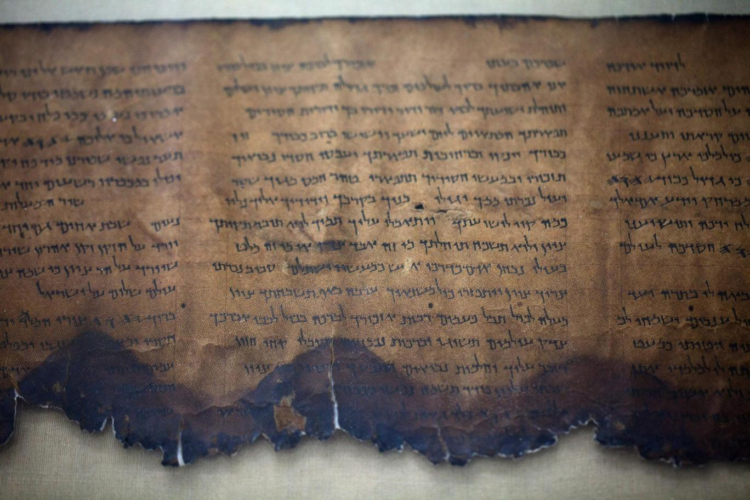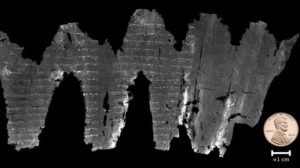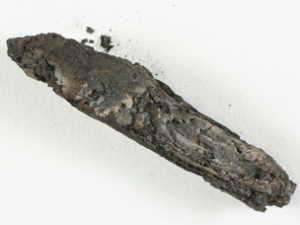Oldest Bible Text Deciphered Through Technological Breakthrough Found to Be Identical to Later Versions : A Well Thought Out Scream by James Riordan

I would like to thank my friend Cole Luck III for turning me on to this story originally based on an article for The Independent written by Andrew Griffin. When I first saw the attached photo of the ancient Hebrew text I was temped to say that scientists were finally able to read the scroll when they realized they had been holding it upside down. Or maybe by holding it up to a mirror. Of course, it has to be a really ancient mirror… Alright now, that I’ve taken the natural scholarly sense of condescendence out of the subject and made it lowbrow enough for my tastes and probably managed to irritate both my friend Cole and Andrew Griffin, I can continue to comment on what really is an important event. You see the scroll was first discovered by archaeologists in 1970 at Ein Gedi, the site of an ancient Jewish community near the Dead Sea. Inside the ancient synagogue’s ark, archaeologists found lumps of scroll fragments. Although the synagogue had been destroyed in an ancient fire. The dry climate of the area kept the charred scrolls preserved. The problem was that the animal-skin document was badly burned and battered. It was so delicate, just touching its surface sent pieces flaking off. To attempt to read it by unwrapping the layers would be to destroy the artifact forever. For curious scholars hoping to know what was written inside, the so-called Ein Gedi Scroll was a hopeless enigma. The archaeologists decided to carefully store the “logs” away and there they remained for nearly half a century, with no one knowing what they contained
The charred Ein Gedi Scroll. Attempting to unwrap the document would destroy it. S. Halevi/Image courtesy of the Leon Levy Dead Sea Scrolls Digital Library
In recent years with funding through Google and the U.S. National Science Foundation researchers from the University of Kentucky created a picture of the writing inside the scroll without unwrapping it, or even touching the charred document much at all. Their findings are described in a paper published Wednesday in the journal Science Advances. Radiocarbon dating suggests the document was written in the third or fourth century, after the Dead Sea Scrolls and before biblical fragments found in Egypt. The writing, in Hebrew, reveals that the Ein Gedi Scroll is a section of Leviticus. It is the oldest Old Testament scroll ever found in the holy ark of a synagogue, according to the study authors. The research team calls the image reconstruction technique the team invented “virtual unwrapping” which is slated to be released to the public as open source software by the end of next year.
Virtual unwrapping is accomplished through four main computational steps. First, the team scanned the charcoal lump with an X-ray technique called microcomputed tomography. Since the scanning equipment doesn’t touch the scroll, it’s nonevasive but the team noted that that even the most delicate imaging technique “necessitates physical handling of the friable material.” So, the curators had to be careful. “The curators do all the work in handling the objects, and they are experts,” explained lead author and computer scientist William Seales in an open reddit forum about the findings. The curators were from the Israel Antiquities Authority, where the scroll is housed.
Once the first step was finished, the scroll’s role in its own deciphering was over, and it went back into protective storage. “I’ve been amazed at how careful and protective they are at moving things around and handling them,” Seales wrote on reddit. “But I’m convinced that this is one of the safest kinds of analysis you can do, short of ‘doing nothing.’ ”
 Next, the team analyzed the X-ray data to figure out where one layer of the rolled-up animal-skin scroll ended and the next one began. The layers were deformed and stretched into different thicknesses. The team wrote an algorithm that basically guessed what each layer would look like, and then compared the data with that guess to map out where the actual layers began and ended.
Next, the team analyzed the X-ray data to figure out where one layer of the rolled-up animal-skin scroll ended and the next one began. The layers were deformed and stretched into different thicknesses. The team wrote an algorithm that basically guessed what each layer would look like, and then compared the data with that guess to map out where the actual layers began and ended.
A virtually unwrapped image of writing on the inside of the partially destroyed Ein Gedi Scroll.
The Israel Antiquities Authority’s Dead Sea Scrolls preservation lab had been creating hi-resolution images of the Dead Sea Scrolls, the earliest copies of biblical texts ever discovered, but last year, when Yosef Porath, the archaeologist who excavated at Ein Gedi in 1970, walked into the lab in Jerusalem with boxes of the charcoal chunks and asked researchers to scan the burned scrolls, Pnina Shor, who head the lab, felt overwhelmed: “I looked at him and said, ‘you must be joking,”‘ said Shor.
Eventually though, Shor agreed, and a number of burned scrolls were scanned using X-ray-based micro-computed tomography, a 3D version of the CT scans hospitals use to create images of internal body parts. The images were then sent to William Brent Seales, a researcher in the computer science department of the University of Kentucky. Only one of the scrolls could be deciphered.
Using the “virtual unwrapping” technology, he and his team painstakingly captured the three-dimensional shape of the scroll’s layers, using a digital triangulated surface mesh to make a virtual rendering of the parts they suspected contained text. They then searched for pixels that could signify ink made with a dense material like iron or lead. The researchers then used computer modeling to virtually flatten the scroll, to be able to read a few columns of text inside.
“Not only were you seeing writing, but it was readable,” said Seales. “At that point we were absolutely jubilant.”
The researchers say it is the first time a biblical scroll has been discovered in an ancient synagogue’s holy ark, where it would have been stored for prayers, and not in desert caves like the Dead Sea Scrolls.
The discovery holds great significance for scholars’ understanding of the development of the Hebrew Bible, researchers say.
In ancient times, many versions of the Hebrew Bible circulated. The Dead Sea Scrolls, dating to as early as the 3rd century B.C., featured versions of the text that are radically different than today’s Hebrew Bible.
Scholars have believed the Hebrew Bible in its standard form first came about some 2,000 years ago, but never had physical proof, until now, according to the study. Previously the oldest known fragments of the modern biblical text dated back to the 8th century.
The text discovered in the charred Ein Gedi scroll is “100 percent identical” to the version of the Book of Leviticus that has been in use for centuries, said Dead Sea Scroll scholar Emmanuel Tov from the Hebrew University of Jerusalem, who participated in the study.
“This is quite amazing for us,” he said. “In 2,000 years, this text has not changed.”
Noam Mizrahi, a Dead Sea Scrolls expert at Tel Aviv University who did not participate in the study, called it a “very, very nice find.” He said the imaging technology holds great potential for more readings of unopened Dead Sea Scrolls. “It’s not only what was found, but the promise of what else it can uncover, which is what will turn this into an exciting discovery,” Mizrahi said.
I personally believe that the Bible is a mystical document which through the power of the Holy Spirit has the ability to “speak” to an individual seeking guidance. Now, naturally, any document that can do that is not going to read like a typical book and will have many apparent contradictions and illogical sections. It’s not a encyclopedia, it’s a mystical document. You either accept it as such on faith or you don’t. It’s not meant to be used to debate the depth of the Red Sea during the Exodus for example. As one old time preacher said, when a scienctific historian argued that the Red Sea was only six inches deep at that point in history, “Praise God!” The historian was surprised, “For what?” he said. “Praise God for what?” The old preacher smiled and replied, “Praise God for drowning the great army of Egypt with their mighty chariots and their powerful horses in six inches of water!” That’s the point. You either accept the Bible as a mystical document and discover that it provides some amazing answers when you need them most or you stick to pure science and miss all that grace. Your choice. But it is interesting to note the consistency of the text here. I’ve written 35 books and human error results in changes in text with just about every edition. Of course, any change discovered in a biblical text would not really bother me because I believe that whatever edition of the Bible I am holding when I ask for God’s guidance will be the one I need at that moment. Just like I believe I can pray to receive something in the mail when I’m walking out to the mailbox to pick up what the postman has already left. Just like I can pray who’s on the other end of the already ringing phone or the person who has already knocked at my door.
You either believe it or you don’t.
___




No Comment